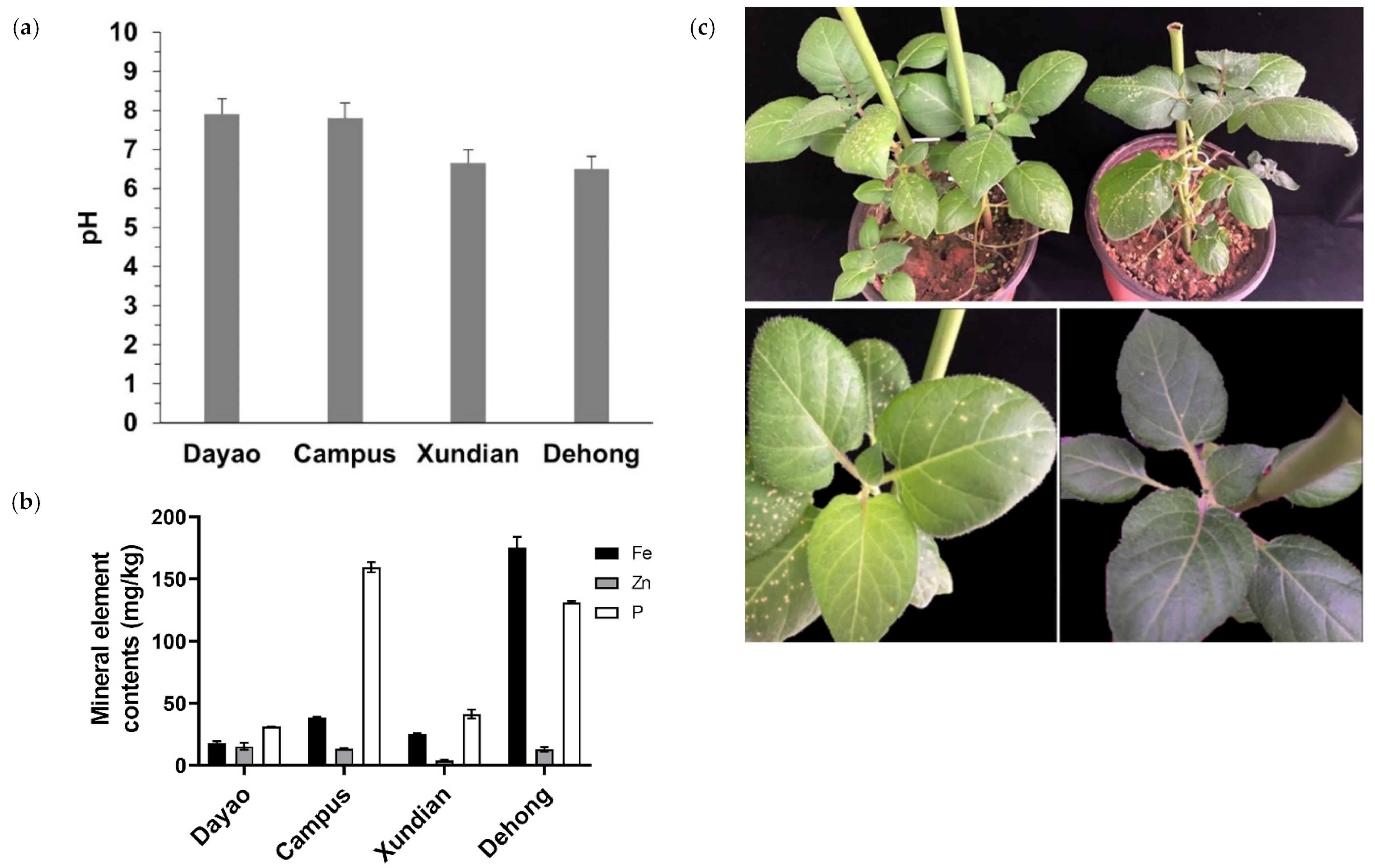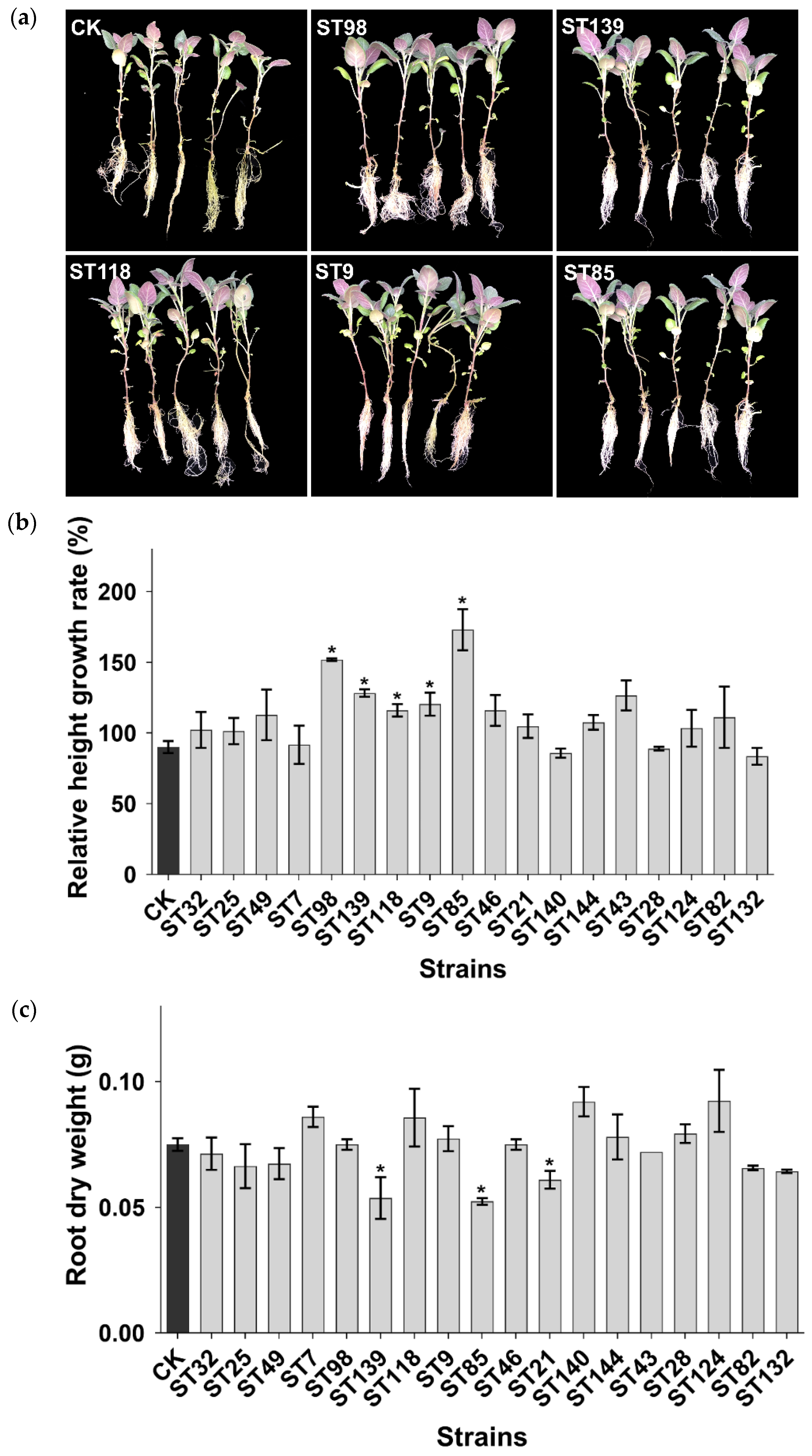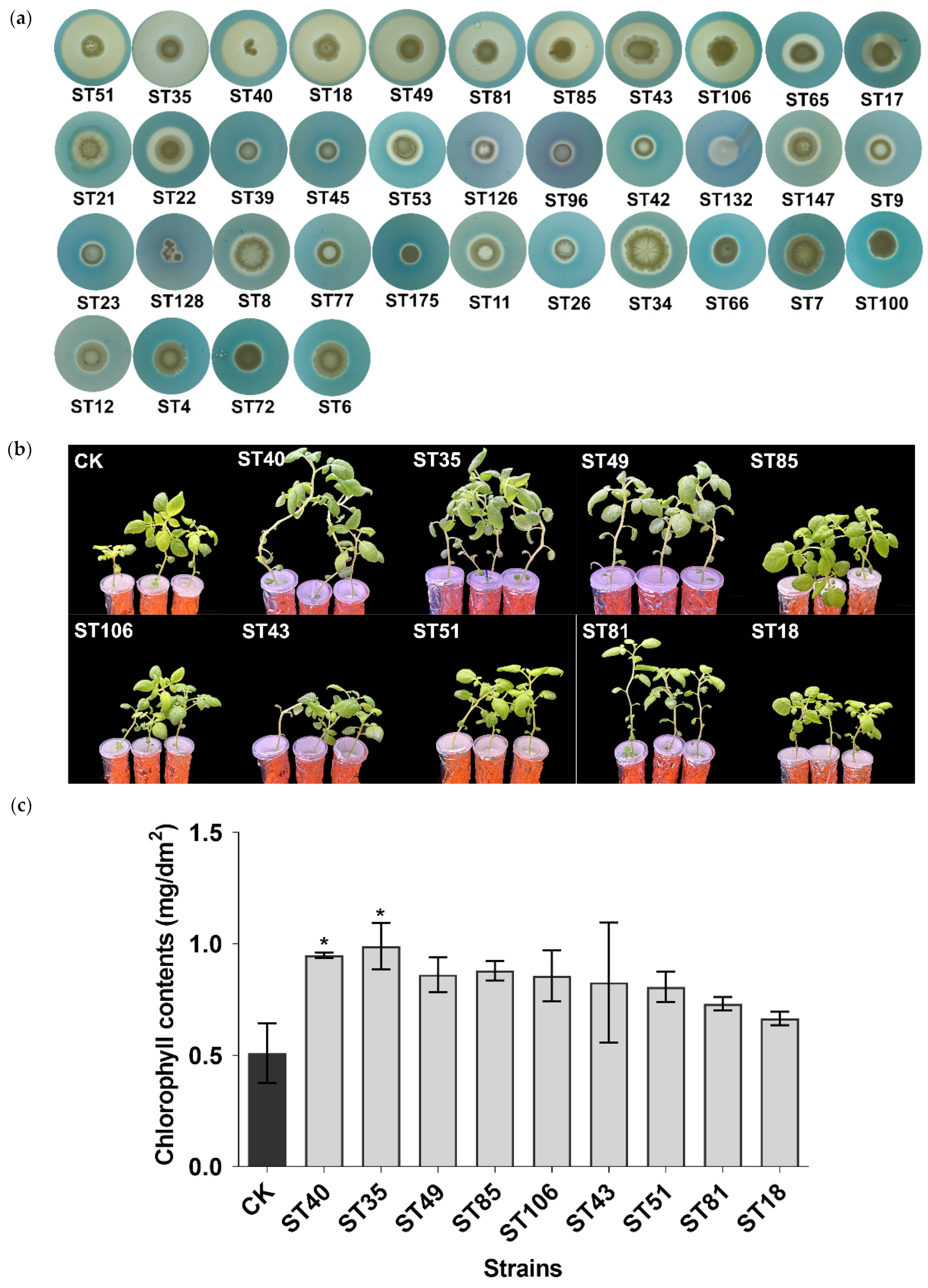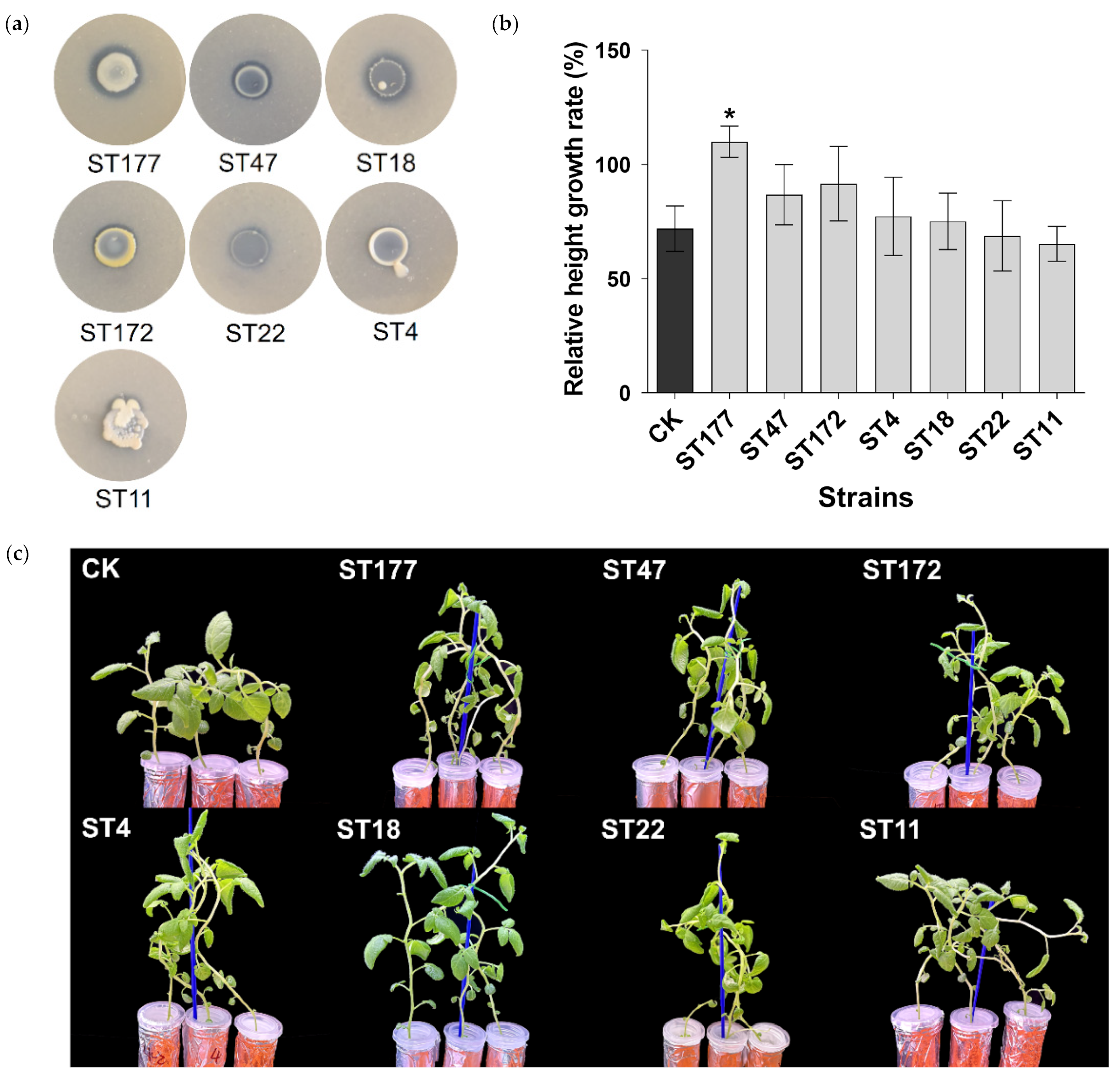Potential Biofertilizers for Alkaline Soil: Bacteria Isolated from the Rhizosphere of Potatoes
Abstract
1. Introduction
2. Materials and Methods
2.1. Soil Sample Collection and Physicochemical Parameter Determination
2.2. Isolation and Purification of Potato Rhizosphere Bacteria
2.3. Sequencing and Phylogenetic Analysis
2.4. Indole Acetic Acid (IAA) Production
2.5. Siderophore Production
2.6. Phosphate Solubilization
2.7. Zinc Solubilization
2.8. Plant–Bacteria Interaction
2.9. Detection of Chlorophyll and Mineral Elements in Plants
2.10. Data Analysis
2.11. Nucleotide Sequence Accession Number
3. Results
3.1. Physicochemical Parameters of Soils
3.2. Identification and Phylogenetic Analysis of Bacteria Isolated from the Potato Rhizosphere
3.3. Rhizosphere Bacterial Strains Promote Plant Growth by Producing IAA
3.4. Rhizosphere Bacterial Strains Promote Plant Iron Absorption by Siderophore Production
3.5. Rhizosphere Bacterial Strains Promote Plant Phosphorus Absorption by Phosphorus Solubilization
3.6. Rhizosphere Bacterial Strains Promote Plant Zinc Absorption by Zinc Solubilization
4. Discussion
5. Conclusions
Supplementary Materials
Author Contributions
Funding
Data Availability Statement
Conflicts of Interest
References
- Devaux, A.; Goffart, J.-P.; Petsakos, A.; Kromann, P.; Gatto, M.; Okello, J.; Suarez, V.; Hareau, G. Global Food Security, Contributions from Sustainable Potato Agri-Food Systems. In The Potato Crop: Its Agricultural, Nutritional and Social Contribution to Humankind; Campos, H., Ortiz, O., Eds.; Springer International Publishing: Cham, Switzerland, 2020; pp. 3–35. [Google Scholar]
- Zhang, H.; Xu, F.; Wu, Y.; Hu, H.; Dai, X. Progress of potato staple food research and industry development in China. J. Integr. Agric. 2017, 16, 2924–2932. [Google Scholar] [CrossRef]
- Buchholz, F.; Antonielli, L.; Kostić, T.; Sessitsch, A.; Mitter, B. The bacterial community in potato is recruited from soil and partly inherited across generations. PLoS ONE 2019, 14, e0223691. [Google Scholar] [CrossRef] [PubMed]
- Olanrewaju, O.S.; Glick, B.R.; Babalola, O.O. Mechanisms of action of plant growth promoting bacteria. World J. Microbiol. Biotechnol. 2017, 33, 197. [Google Scholar] [CrossRef]
- Xu, F.; Liao, H.; Yang, J.; Zhang, Y.; Yu, P.; Cao, Y.; Fang, J.; Chen, S.; Li, L.; Sun, L.; et al. Auxin-producing bacteria promote barley rhizosheath formation. Nat. Commun. 2023, 14, 5800. [Google Scholar] [CrossRef] [PubMed]
- Hakim, S.; Naqqash, T.; Nawaz, M.S.; Laraib, I.; Siddique, M.J.; Zia, R.; Mirza, M.S.; Imran, A. Rhizosphere Engineering With Plant Growth-Promoting Microorganisms for Agriculture and Ecological Sustainability. Front. Sustain. Food Syst. 2021, 5, 617157. [Google Scholar] [CrossRef]
- Petrushin, I.S.; Filinova, N.V.; Gutnik, D.I. Potato Microbiome: Relationship with Environmental Factors and Approaches for Microbiome Modulation. Int. J. Mol. Sci. 2024, 25, 750. [Google Scholar] [CrossRef] [PubMed]
- Santoyo, G. How plants recruit their microbiome? New insights into beneficial interactions. J. Adv. Res. 2022, 40, 45–58. [Google Scholar] [CrossRef] [PubMed]
- Wen, Z.; White, P.J.; Shen, J.; Lambers, H. Linking root exudation to belowground economic traits for resource acquisition. New Phytol. 2022, 233, 1620–1635. [Google Scholar] [CrossRef] [PubMed]
- Harbort, C.J.; Hashimoto, M.; Inoue, H.; Niu, Y.; Schulze-Lefert, P. Root-Secreted Coumarins and the Microbiota Interact to Improve Iron Nutrition in Arabidopsis. Cell Host Microbe 2020, 28, 825–837.e6. [Google Scholar] [CrossRef]
- Tato, L.; Lattanzio, V.; Ercole, E.; Dell’Orto, M.; Sorgonà, A.; Linsalata, V.; Salvioli di Fossalunga, A.; Novero, M.; Astolfi, S.; Abenavoli, M.R.; et al. Plasticity, exudation and microbiome-association of the root system of Pellitory-of-the-wall plants grown in environments impaired in iron availability. Plant Physiol. Biochem. PPB 2021, 168, 27–42. [Google Scholar] [CrossRef]
- Guo, Z.; Wang, X.; Zhang, X.; Wang, R.; Wang, S.; Chen, Y.; Liu, J.; Tian, H.; Wang, Z.; Shi, M. Rhizosphere microbiome-related changes in soil zinc and phosphorus availability improve grain zinc concentration of wheat. Plant Soil 2023, 490, 651–668. [Google Scholar] [CrossRef]
- Lindsay, W.L.; Norvell, W.A. Development of a DTPA Soil Test for Zinc, Iron, Manganese, and Copper. Soil Sci. Soc. Am. J. 1978, 42, 421–428. [Google Scholar] [CrossRef]
- Shen, Y.; Ma, Z.; Chen, H.; Lin, H.; Li, G.; Li, M.; Tan, D.; Gao, W.; Jiao, S.; Liu, P.; et al. Effects of macromolecular organic acids on reducing inorganic phosphorus fixation in soil. Heliyon 2023, 9, e14892. [Google Scholar] [CrossRef] [PubMed]
- Kesaulya, H.; Baharuddin; Zakaria, B.; Syaiful, S.A. Isolation and Physiological Characterization of PGPR from Potato Plant Rhizosphere in Medium Land of Buru Island. Procedia Food Sci. 2015, 3, 190–199. [Google Scholar] [CrossRef]
- Weisburg, W.G.; Barns, S.M.; Pelletier, D.A.; Lane, D.J. 16S ribosomal DNA amplification for phylogenetic study. J. Bacteriol. 1991, 173, 697–703. [Google Scholar] [CrossRef] [PubMed]
- Suliasih; Widawati, S. Isolation of Indole Acetic Acid (IAA) producing Bacillus siamensis from peat and optimization of the culture conditions for maximum IAA production. IOP Conf. Ser. Earth Environ. Sci. 2020, 572, 012025. [Google Scholar] [CrossRef]
- Louden, B.C.; Haarmann, D.; Lynne, A.M. Use of blue agar CAS assay for siderophore detection. J. Microbiol. Biol. Educ. 2011, 12, 51–53. [Google Scholar] [CrossRef] [PubMed]
- Dinesh, R.; Srinivasan, V.; Hamza, S.; Sarathambal, C.; Anke Gowda, S.J.; Ganeshamurthy, A.N.; Gupta, S.B.; Aparna Nair, V.; Subila, K.P.; Lijina, A.; et al. Isolation and characterization of potential Zn solubilizing bacteria from soil and its effects on soil Zn release rates, soil available Zn and plant Zn content. Geoderma 2018, 321, 173–186. [Google Scholar] [CrossRef]
- Hiscox, J.D.; Israelstam, G.F. A method for the extraction of chlorophyll from leaf tissue without maceration. Can. J. Bot. 1979, 57, 1332–1334. [Google Scholar] [CrossRef]
- White, P.J.; George, T.S.; Gregory, P.J.; Bengough, A.G.; Hallett, P.D.; McKenzie, B.M. Matching roots to their environment. Ann. Bot. 2013, 112, 207–222. [Google Scholar]
- Lynch, J.P. Root phenotypes for improved nutrient capture: An underexploited opportunity for global agriculture. New Phytol. 2019, 223, 548–564. [Google Scholar] [CrossRef] [PubMed]
- Rowe, H.; Withers, P.J.; Baas, P.; Chan, N.I.; Doody, D.; Holiman, J.; Jacobs, B.; Li, H.; MacDonald, G.K.; McDowell, R. Integrating legacy soil phosphorus into sustainable nutrient management strategies for future food, bioenergy and water security. Nutr. Cycl. Agroecosyst. 2016, 104, 393–412. [Google Scholar] [CrossRef]
- Raymond, N.S.; Gómez-Muñoz, B.; van der Bom, F.J.; Nybroe, O.; Jensen, L.S.; Müller-Stöver, D.S.; Oberson, A.; Richardson, A.E. Phosphate-solubilising microorganisms for improved crop productivity: A critical assessment. New Phytol. 2021, 229, 1268–1277. [Google Scholar] [CrossRef] [PubMed]
- Sodhi, K.K.; Kumar, M.; Dhaulaniya, A.S.; Balan, B.; Singh, D.K.J.E.S. Enhanced ciprofloxacin removal by plant growth-promoting Microbacterium sp. WHC1 in presence of Eichhornia crassipes root exudates. Environ. Sustain. 2021, 4, 143–153. [Google Scholar] [CrossRef]
- Kaur, G.J.K.; Dadhich, K.S.S.; CAMEOTRA, A.S.S. Phosphate-Solubilizing bacteria Microbacterium paraoxydans isolated from the rhizospheric system of wheat (Teiticum aestivum). Wetl. Divers. Agron. 2011, 12, e9062. [Google Scholar]
- Siraj, S.; Khan, M.A.; Hamayun, M.; Ali, S.; Khan, S.A.; Hussain, A.; Iqbal, A.; Khan, H.; Kang, S.-M.; Lee, I.-J. Microbacterium oxydans Regulates Physio-Hormonal and Molecular Attributes of Solanum lycopersicum under Drought Stress. Agronomy 2022, 12, 3224. [Google Scholar] [CrossRef]
- Zheng, J.; Liao, Y.; Li, Y.; Li, D.; Sun, Y.; Xiao, Z. Description of Microbacterium dauci sp. nov., a plant growth hormone indoleacetic acid-producing and nitrogen-fixing bacterium isolated from carrot rhizosphere soil. Arch. Microbiol. 2024, 206, 102. [Google Scholar] [CrossRef] [PubMed]
- Verma, S.; Kumar, M.; Kumar, A.; Das, S.; Chakdar, H.; Varma, A.; Saxena, A.K. Diversity of Bacterial Endophytes of Maize (Zea mays) and Their Functional Potential for Micronutrient Biofortification. Curr. Microbiol. 2021, 79, 6. [Google Scholar] [CrossRef] [PubMed]
- Egamberdieva, D. Indole-Acetic Acid Production by Root Associated Bacteria and its Role in Plant Growth and Development; Nova Publishers: Hauppauge, NY, USA, 2012. [Google Scholar]
- Chhetri, G.; Kim, I.; Kim, J.; So, Y.; Seo, T. Chryseobacterium tagetis sp. nov., a plant growth promoting bacterium with an antimicrobial activity isolated from the roots of medicinal plant (Tagetes patula). J. Antibiot. 2022, 75, 312–320. [Google Scholar] [CrossRef]
- Li, M.; Guo, R.; Yu, F.; Chen, X.; Zhao, H.; Li, H.; Wu, J. Indole-3-Acetic Acid Biosynthesis Pathways in the Plant-Beneficial Bacterium Arthrobacter pascens ZZ21. Int. J. Mol. Sci. 2018, 19, 443. [Google Scholar] [CrossRef]
- Jiang, F.; Chen, L.; Belimov, A.A.; Shaposhnikov, A.I.; Gong, F.; Meng, X.; Hartung, W.; Jeschke, D.W.; Davies, W.J.; Dodd, I.C. Multiple impacts of the plant growth-promoting rhizobacterium Variovorax paradoxus 5C-2 on nutrient and ABA relations of Pisum sativum. J. Exp. Bot. 2012, 63, 6421–6430. [Google Scholar] [CrossRef] [PubMed]
- Zhang, Y.; Zhao, J.; Hu, J.; Han, C.; Yu, B.; Wu, Y.; Xiao, J.; Wang, X.; Xiang, W. Agromyces mariniharenae sp. nov., a novel indole-acetic acid producing actinobacterium isolated from marine sand. Int. J. Syst. Evol. Microbiol. 2021, 71, 5026. [Google Scholar] [CrossRef]
- Jung, W.; Song, Y.S.; Seo, D.J.; Lee, J.H.J. Antifungal Activity and Properties of Crude Enzymes Produced from Cellulomonas fimi JH-1. J. Chitin Chitosan 2022, 27, 59–68. [Google Scholar] [CrossRef]
- Zheng, Y.; Tang, J.; Liu, C.; Liu, X.; Luo, Z.; Zou, D.; Xiang, G.; Bai, J.; Meng, G.; Liu, X.; et al. Alleviation of metal stress in rape seedlings (Brassica napus L.) using the antimony-resistant plant growth-promoting rhizobacteria Cupriavidus sp. S-8-2. Sci. Total Environ. 2023, 858, 159955. [Google Scholar] [CrossRef]
- Chatterjee, S.; Sau, G.B.; Mukherjee, S.K. Plant growth promotion by a hexavalent chromium reducing bacterial strain, Cellulosimicrobium cellulans KUCr3. World J. Microbiol. Biotechnol. 2009, 25, 1829–1836. [Google Scholar] [CrossRef]
- Katiyar, P.; Dubey, R.C.; Maheshwari, D.K. ACC deaminase-producing Ensifer adhaerens KS23 enhances proximate nutrient of Pisum sativum L. cultivated in high altitude. Arch. Microbiol. 2021, 203, 2689–2698. [Google Scholar] [CrossRef]
- Kaur, H.; Sharma, P.; Kaur, N.; Gill, B.S. Tapping of native Bradyrhizobium and Ensifer sp. diversity for functional traits in soybean [Glycine max (L.) Merrill]. Legume Res. 2014, 37, 651–657. [Google Scholar] [CrossRef]
- Kraemer, S.M. Iron oxide dissolution and solubility in the presence of siderophores. Aquat. Sci. 2004, 66, 3–18. [Google Scholar] [CrossRef]
- Vansuyt, G.; Robin, A.; Briat, J.F.; Curie, C.; Lemanceau, P. Iron acquisition from Fe-pyoverdine by Arabidopsis thaliana. Mol. Plant-Microbe Interact. 2007, 20, 441–447. [Google Scholar] [CrossRef]
- Kramer, J.; Özkaya, Ö.; Kümmerli, R. Bacterial siderophores in community and host interactions. Nat. Rev. Microbiol. 2020, 18, 152–163. [Google Scholar] [CrossRef]
- Gu, S.; Wei, Z.; Shao, Z.; Friman, V.-P.; Cao, K.; Yang, T.; Kramer, J.; Wang, X.; Li, M.; Mei, X. Competition for iron drives phytopathogen control by natural rhizosphere microbiomes. Nat. Microbiol. 2020, 5, 1002–1010. [Google Scholar] [CrossRef]
- Andrić, S.; Rigolet, A.; Argüelles Arias, A.; Steels, S.; Hoff, G.; Balleux, G.; Ongena, L.; Höfte, M.; Meyer, T.; Ongena, M. Plant-associated Bacillus mobilizes its secondary metabolites upon perception of the siderophore pyochelin produced by a Pseudomonas competitor. ISME J. 2023, 17, 263–275. [Google Scholar] [CrossRef] [PubMed]
- Alka, S.; Shahir, S.; Ibrahim, N.; Vo, D.-V.N.; Abd Manan, F. Assessment of plant growth promotion properties and impact of Microbacterium foliorum for arsenic removal in Melastoma Malabathricum. Bioremediat. J. 2023, 27, 251–262. [Google Scholar] [CrossRef]
- Kumar, M.; Singh, R.P.J.C.C.; Sustainability, E. Plant Growth Promoting Activities of Microbacterium phyllosphaerae in Wheat (Triticum aestivum L.). Agric. Food Sci. 2018, 6, 79. [Google Scholar] [CrossRef]
- Cabello-Conejo, M.I.; Becerra-Castro, C.; Prieto-Fernández, A.; Monterroso, C.; Saavedra-Ferro, A.; Mench, M.; Kidd, P.S. Rhizobacterial inoculants can improve nickel phytoextraction by the hyperaccumulator Alyssum pintodasilvae. Plant Soil 2014, 379, 35–50. [Google Scholar] [CrossRef]
- Lincoln, A.; Mandal, S.; Environment, K.J. Isolation and Assessment of Plant Growth Promoting Activity of Siderophore Producing Pseudomonas fluorescens in Crops. Int. J. Agric. Environ. Biotechnol. 2014, 7, 63–67. [Google Scholar]
- Rondon, M.R.; Ballering, K.S.; Thomas, M.G. Identification and analysis of a siderophore biosynthetic gene cluster from Agrobacterium tumefaciens C58. Microbiology 2004, 150, 3857–3866. [Google Scholar] [CrossRef] [PubMed]
- Peng, Y.; Jiang, L.; Jeon, D.; Cho, D.; Kim, Y.; Kim, C.Y.; Lee, J.H.; Lee, J. Pseudoxanthomonas sp. JBR18, a halotolerant endophytic bacterium, improves the salt tolerance of Arabidopsis seedlings. Plant Physiol. Biochem. 2024, 207, 108415. [Google Scholar] [CrossRef] [PubMed]
- Flores Clavo, R.; Valladolid-Suyón, E.; Reinoza-Farroñan, K.; Asmat Ortega, C.; Riboldi Monteiro, P.H.; Apaza-Castillo, G.A.; Zuñiga-Valdera, G.; Fantinatti Garboggini, F.; Iglesias-Osores, S.; Carreño-Farfán, C.R. Rhizobacterial Isolates from Prosopis limensis Promote the Growth of Raphanus sativus L. Under Salt Stress. Curr. Microbiol. 2023, 80, 269. [Google Scholar] [CrossRef]
- Madhaiyan, M.; Poonguzhali, S.; Lee, J.-S.; Senthilkumar, M.; Lee, K.C.; Sundaram, S. Leifsonia soli sp. nov., a yellow-pigmented actinobacterium isolated from teak rhizosphere soil. Int. J. Syst. Evol. Microbiol. 2010, 60, 1322–1327. [Google Scholar] [CrossRef]
- Sowmya, S.; Rekha, P.D.; Arun, A.B. Isolation, identification and characterization of Curtobacterium sp. YU-SS-C-67 for phosphate solubilization and uranium tolerance. Int. Res. J. Biol. Sci. 2013, 2, 102–106. [Google Scholar]
- Jha, B.K.; Gandhi, P.M.; Cletus, J.; Raman, G.; Sakthivel, N. Simultaneous phosphate solubilization potential and antifungal activity of new fluorescent pseudomonad strains, Pseudomonasaeruginosa, P. plecoglossicida and P. mosselii. World J. Microbiol. Biotechnol. 2009, 25, 573–581. [Google Scholar] [CrossRef]
- Brito, L.; Lopez, M.G.; Straube, L.; Wendisch, V.F. Inorganic Phosphate Solubilization by Rhizosphere Bacterium Paenibacillus sonchi: Gene Expression and Physiological Functions. Front. Microbiol. 2020, 11, 588605. [Google Scholar] [CrossRef]
- Weigold, P.; Adaktylou, I.J.; Kappler, A.; Behrens, S.; Mühe, E.-M. Rhizosphere Microbial Community Composition Affects Cadmium and Zinc Uptake by the Metal-Hyperaccumulating Plant Arabidopsis halleri. Appl. Environ. Microbiol. 2019, 81, 2173–2181. [Google Scholar] [CrossRef]
- Jung, H.; Lee, D.; Lee, S.; Kong, H.J.; Park, J.; Seo, Y.-S. Comparative genomic analysis of Chryseobacterium species: Deep insights into plant-growth-promoting and halotolerant capacities. Microb. Genom. 2023, 9, 001108. [Google Scholar] [CrossRef] [PubMed]
- Rahman, A.; Ahmad, M.A.; Mehmood, S.; Rauf, A.; Iqbal, A.; Ali, B.; Ullah, M.; Ali, M.; Mohamed, H.I.; Uddin, I. Isolation and Screening of Zn (Zn) Solubilizing Rhizosphere Bacteria from Different Vegetations for Their Ability to Improve Growth, Zn Uptake, and Expression of Zn Transporter Genes in Tomato. Curr. Microbiol. 2024, 81, 83. [Google Scholar] [CrossRef] [PubMed]
- Mike-Anosike, E.; Braidedr, W.; Adeleye, S.A. International Journal of Advanced Research in Biological Sciences Studies on Indole Acetic Acid (IAA) Production by Rhizobacteria and Growth promoting potentials. Int. J. Adv. Res. Biol. Sci. 2018, 5, 133–140. [Google Scholar]
- Roosta, H.R.; Estaji, A.; Niknam, F. Effect of iron, zinc and manganese shortage-induced change on photosynthetic pigments, some osmoregulators and chlorophyll fluorescence parameters in lettuce. Photosynthetica 2018, 56, 606–615. [Google Scholar] [CrossRef]
- Martins, S.J.; Pasche, J.; Silva, H.A.O.; Selten, G.; Savastano, N.; Abreu, L.M.; Bais, H.P.; Garrett, K.A.; Kraisitudomsook, N.; Pieterse, C.M.J.; et al. The Use of Synthetic Microbial Communities to Improve Plant Health. Phytopathology 2023, 113, 1369–1379. [Google Scholar] [CrossRef]






| Strains | IAA Contents (mg/L) | Strains | IAA Contents (mg/L) |
|---|---|---|---|
| ST32 | 43.16 ± 0.5894 | ST146 | 1.69 ± 0.0192 |
| ST25 | 23.57 ± 0.7434 | ST112 | 1.67 ± 0.1761 |
| ST49 | 23.47 ± 0.235 | ST50 | 1.41 ± 0.0419 |
| ST7 | 14.18 ± 0.4438 | ST4 | 1.37 ± 0.3029 |
| ST98 | 9.81 ± 0.8337 | ST1 | 1.15 ± 0.0679 |
| ST139 | 9.6 ± 0.3101 | ST128 | 1.14 ± 0.2128 |
| ST118 | 7.79 ± 0.2416 | ST130 | 1.05 ± 0.0712 |
| ST9 | 7.5 ± 0.3165 | ST176 | 0.96 ± 0.0546 |
| ST85 | 6.13 ± 0.1182 | ST22 | 0.96 ± 0.0726 |
| ST46 | 6.05 ± 0.1425 | ST55 | 0.93 ± 0.0144 |
| ST21 | 5.93 ± 0.1774 | ST68 | 0.92 ± 0.0173 |
| ST140 | 5.88 ± 0.2822 | ST14 | 0.84 ± 0.0127 |
| ST144 | 5.67 ± 0.319 | ST145 | 0.71 ± 0.1446 |
| ST43 | 5.56 ± 0.0459 | ST107 | 0.69 ± 0.1248 |
| ST28 | 4.38 ± 0.166 | ST121 | 0.69 ± 0.1357 |
| ST124 | 3.89 ± 0.2196 | ST26 | 0.49 ± 0.0474 |
| ST82 | 3.84 ± 0.0679 | ST70 | 0.48 ± 0.1639 |
| ST132 | 3.16 ± 0.1692 | ST17 | 0.34 ± 0.1901 |
| ST173 | 2.43 ± 0.0804 | ST51 | 0.31 ± 0.0694 |
| ST35 | 2.34 ± 0.2021 | ST12 | 0.23 ± 0.0614 |
| ST116 | 2.09 ± 0.0939 | ST100 | 0.18 ± 0.0139 |
| ST172 | 2.03 ± 0.5157 | ST175 | 0.16 ± 0.0948 |
| ST73 | 1.94 ± 0.141 | ST97 | 0.15 ± 0.036 |
| ST40 | 1.92 ± 0.0756 |
| Strains | Solubilization Index (SI) | Strains | Solubilization Index (SI) |
|---|---|---|---|
| ST51 | 2.72 ± 0.0473 | ST132 | 1.25 ± 0.0056 |
| ST35 | 2.57 ± 0.0552 | ST147 | 1.25 ± 0.0029 |
| ST40 | 2.66 ± 0.1117 | ST23 | 1.18 ± 0.0025 |
| ST18 | 2.29 ± 0.0072 | ST8 | 1.17 ± 0.0085 |
| ST49 | 2.08 ± 0.0087 | ST128 | 1.18 ± 0.0101 |
| ST81 | 2.02 ± 0.015 | ST77 | 1.15 ± 0.0214 |
| ST85 | 1.92 ± 0.0532 | ST9 | 1.19 ± 0.0391 |
| ST43 | 1.77 ± 0.025 | ST175 | 1.12 ± 0.0028 |
| ST106 | 1.73 ± 0.018 | ST26 | 1.1 ± 0.012 |
| ST17 | 1.54 ± 0.019 | ST11 | 1.11 ± 0.0074 |
| ST39 | 1.45 ± 0.0262 | ST66 | 1.08 ± 0.0016 |
| ST22 | 1.47 ± 0.0336 | ST12 | 1.05 ± 0.0225 |
| ST65 | 1.5 ± 0.054 | ST7 | 1.08 ± 0.0036 |
| ST21 | 1.42 ± 0.0836 | ST34 | 1.07 ± 0.0148 |
| ST45 | 1.31 ± 0.0207 | ST6 | 1.05 ± 0.0195 |
| ST53 | 1.29 ± 0.0067 | ST100 | 1.07 ± 0.0186 |
| ST126 | 1.27 ± 0.0177 | ST4 | 1.05 ± 0.0093 |
| ST96 | 1.27 ± 0.0057 | ST72 | 1.02 ± 0.0097 |
| ST42 | 1.26 ± 0.0056 |
| Strains | Solubilization Index (SI) |
|---|---|
| ST177 | 1.35 ± 0.2046 |
| ST47 | 1.27 ± 0.0433 |
| ST172 | 1.23 ± 0.0396 |
| ST18 | 1.27 ± 0.0584 |
| ST22 | 1.15 ± 0.0496 |
| ST4 | 1.07 ± 0.0278 |
| ST11 | 1.06 ± 0.0014 |
| Strains | Solubilization Index (SI) |
|---|---|
| ST103 | 2.4 ± 0.0111 |
| ST32 | 1.47 ± 0.0384 |
| ST34 | 1.16 ± 0.0411 |
| ST85 | 1.08 ± 0.0072 |
Disclaimer/Publisher’s Note: The statements, opinions and data contained in all publications are solely those of the individual author(s) and contributor(s) and not of MDPI and/or the editor(s). MDPI and/or the editor(s) disclaim responsibility for any injury to people or property resulting from any ideas, methods, instructions or products referred to in the content. |
© 2024 by the authors. Licensee MDPI, Basel, Switzerland. This article is an open access article distributed under the terms and conditions of the Creative Commons Attribution (CC BY) license (https://creativecommons.org/licenses/by/4.0/).
Share and Cite
Yu, Z.; Chen, C.; Li, Z.; Song, Y.; Yan, C.; Jiang, X.; Jia, H.; Shang, Y.; Tian, M. Potential Biofertilizers for Alkaline Soil: Bacteria Isolated from the Rhizosphere of Potatoes. Agronomy 2024, 14, 1241. https://doi.org/10.3390/agronomy14061241
Yu Z, Chen C, Li Z, Song Y, Yan C, Jiang X, Jia H, Shang Y, Tian M. Potential Biofertilizers for Alkaline Soil: Bacteria Isolated from the Rhizosphere of Potatoes. Agronomy. 2024; 14(6):1241. https://doi.org/10.3390/agronomy14061241
Chicago/Turabian StyleYu, Zhongchen, Caiding Chen, Zhou Li, Yunjie Song, Chunhong Yan, Xinyu Jiang, Heng Jia, Yi Shang, and Mengqing Tian. 2024. "Potential Biofertilizers for Alkaline Soil: Bacteria Isolated from the Rhizosphere of Potatoes" Agronomy 14, no. 6: 1241. https://doi.org/10.3390/agronomy14061241
APA StyleYu, Z., Chen, C., Li, Z., Song, Y., Yan, C., Jiang, X., Jia, H., Shang, Y., & Tian, M. (2024). Potential Biofertilizers for Alkaline Soil: Bacteria Isolated from the Rhizosphere of Potatoes. Agronomy, 14(6), 1241. https://doi.org/10.3390/agronomy14061241







